YAMAHA XVS1100A 2000 User Guide
Manufacturer: YAMAHA, Model Year: 2000, Model line: XVS1100A, Model: YAMAHA XVS1100A 2000Pages: 104, PDF Size: 14.79 MB
Page 11 of 104

DESCRIPTION
2
Left view (XVS1100) .......................................................................... 2-1
Right view (XVS1100) ........................................................................ 2-2
Left view (XVS1100A) ........................................................................ 2-3
Right view (XVS1100A) ...................................................................... 2-4
Controls and instruments (XVS1100/XVS1100A) .............................. 2-5
E_5KS.book Page 1 Monday, August 21, 2000 10:48 AM
Page 12 of 104

2-1
2
EAU00026
2-DESCRIPTIONLeft view (XVS1100)1. Shift pedal (page 3-6)
2. Fuel cock (page 3-9)
3. Spring preload adjusting ring (shock absorber assembly) (page 3-15)
4. Helmet holder (page 3-13)
5. Storage compartment (page 3-14)
6. Owner’s tool kit (page 6-1)
7. Fuses (page 6-27)
8. Oil level check window (page 6-7)
E_5KS.book Page 1 Monday, August 21, 2000 10:48 AM
Page 13 of 104
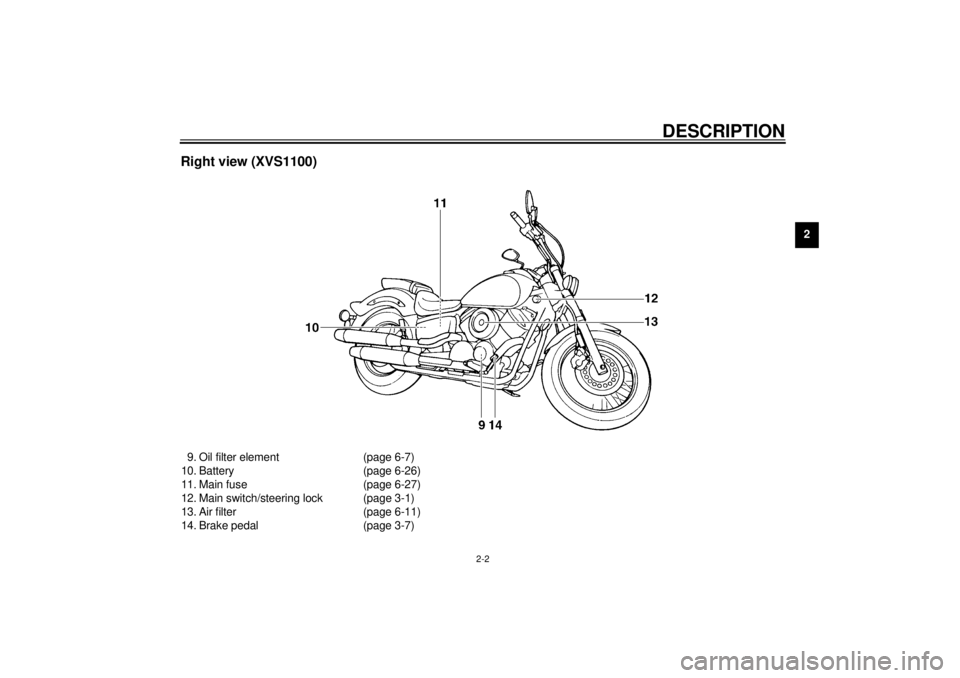
DESCRIPTION
2-2
2
Right view (XVS1100)9. Oil filter element (page 6-7)
10. Battery (page 6-26)
11. Main fuse (page 6-27)
12. Main switch/steering lock (page 3-1)
13. Air filter (page 6-11)
14. Brake pedal (page 3-7)
E_5KS.book Page 2 Monday, August 21, 2000 10:48 AM
Page 14 of 104
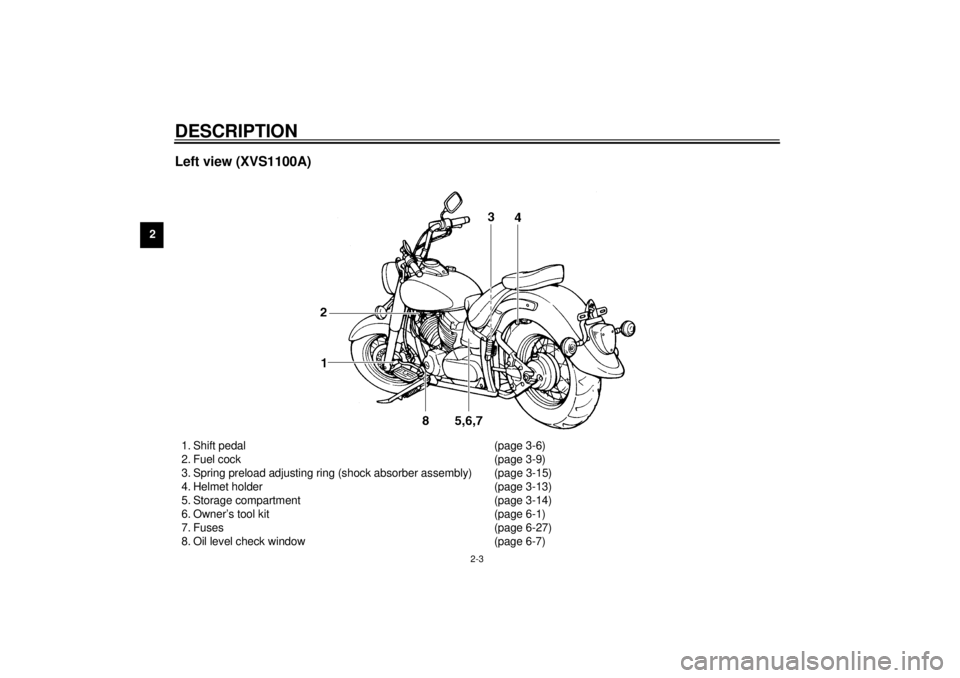
DESCRIPTION
2-3
2
Left view (XVS1100A)1. Shift pedal (page 3-6)
2. Fuel cock (page 3-9)
3. Spring preload adjusting ring (shock absorber assembly) (page 3-15)
4. Helmet holder (page 3-13)
5. Storage compartment (page 3-14)
6. Owner’s tool kit (page 6-1)
7. Fuses (page 6-27)
8. Oil level check window (page 6-7)
E_5KS.book Page 3 Monday, August 21, 2000 10:48 AM
Page 15 of 104
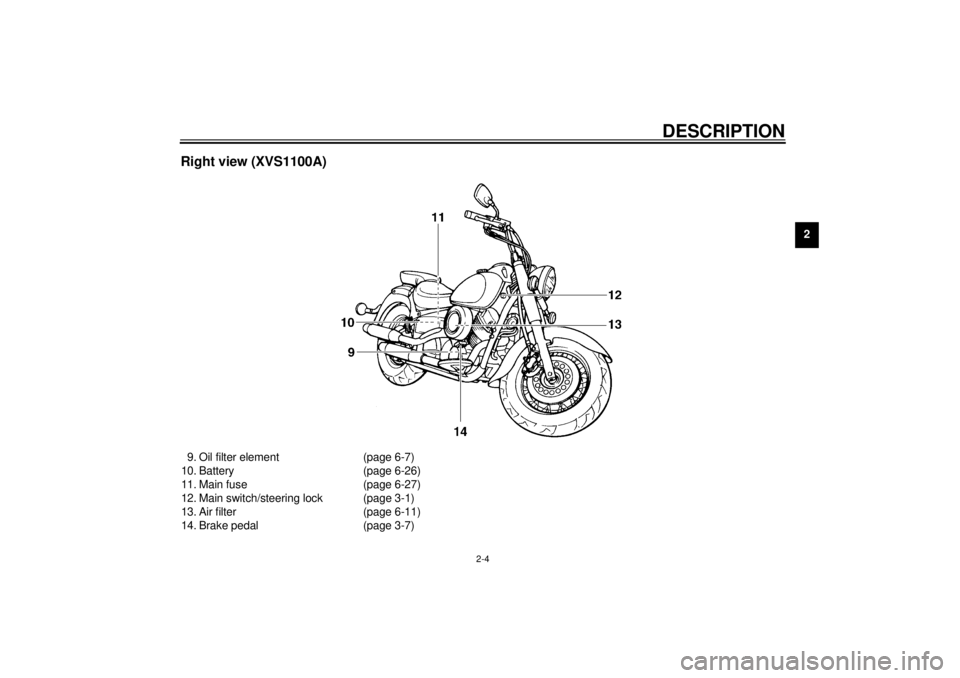
DESCRIPTION
2-4
2
Right view (XVS1100A)9. Oil filter element (page 6-7)
10. Battery (page 6-26)
11. Main fuse (page 6-27)
12. Main switch/steering lock (page 3-1)
13. Air filter (page 6-11)
14. Brake pedal (page 3-7)
E_5KS.book Page 4 Monday, August 21, 2000 10:48 AM
Page 16 of 104
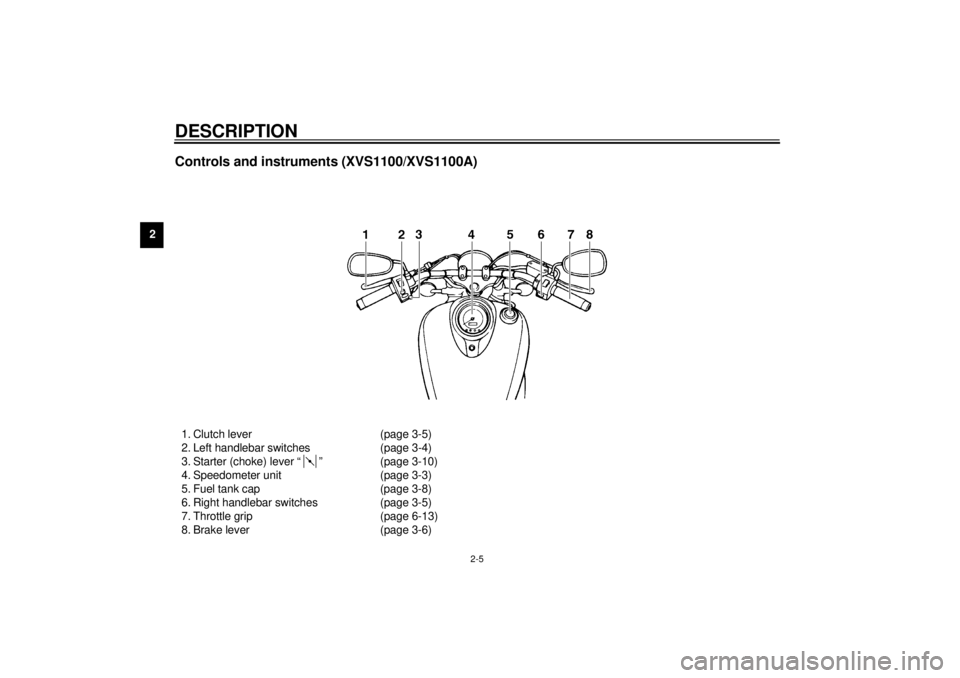
DESCRIPTION
2-5
2
Controls and instruments (XVS1100/XVS1100A)1. Clutch lever (page 3-5)
2. Left handlebar switches (page 3-4)
3. Starter (choke) lever “ ” (page 3-10)
4. Speedometer unit (page 3-3)
5. Fuel tank cap (page 3-8)
6. Right handlebar switches (page 3-5)
7. Throttle grip (page 6-13)
8. Brake lever (page 3-6)
E_5KS.book Page 5 Monday, August 21, 2000 10:48 AM
Page 17 of 104
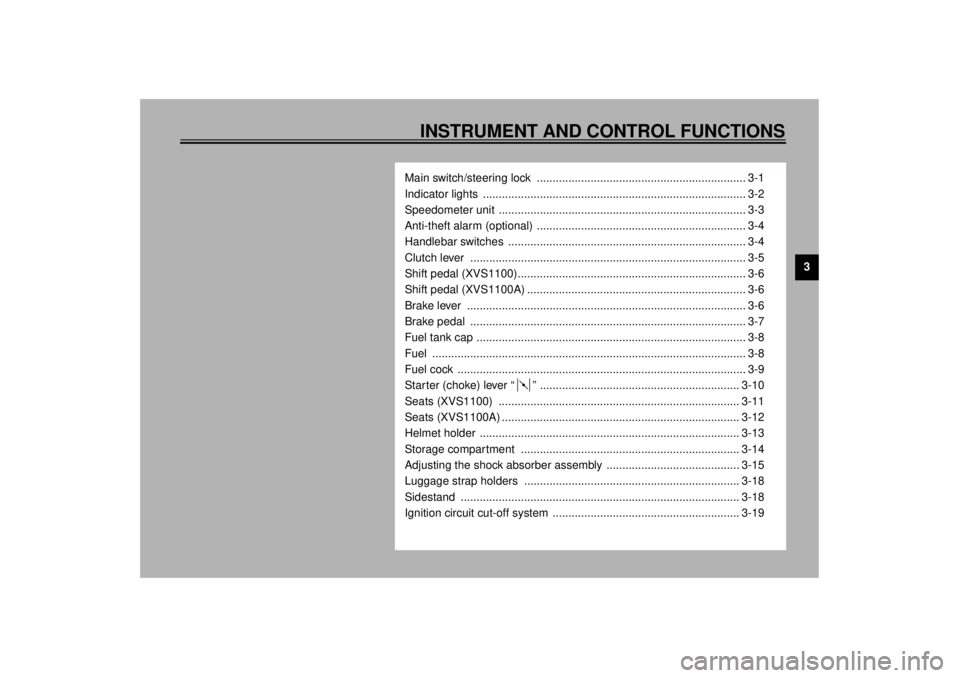
INSTRUMENT AND CONTROL FUNCTIONS
3
Main switch/steering lock .................................................................. 3-1
Indicator lights ................................................................................... 3-2
Speedometer unit .............................................................................. 3-3
Anti-theft alarm (optional) .................................................................. 3-4
Handlebar switches ........................................................................... 3-4
Clutch lever ....................................................................................... 3-5
Shift pedal (XVS1100)........................................................................ 3-6
Shift pedal (XVS1100A) ..................................................................... 3-6
Brake lever ........................................................................................ 3-6
Brake pedal ....................................................................................... 3-7
Fuel tank cap ..................................................................................... 3-8
Fuel ................................................................................................... 3-8
Fuel cock ........................................................................................... 3-9
Starter (choke) lever “ ” ............................................................... 3-10
Seats (XVS1100) ............................................................................ 3-11
Seats (XVS1100A) ........................................................................... 3-12
Helmet holder .................................................................................. 3-13
Storage compartment ..................................................................... 3-14
Adjusting the shock absorber assembly .......................................... 3-15
Luggage strap holders .................................................................... 3-18
Sidestand ........................................................................................ 3-18
Ignition circuit cut-off system ........................................................... 3-19
E_5KS.book Page 1 Monday, August 21, 2000 10:48 AM
Page 18 of 104
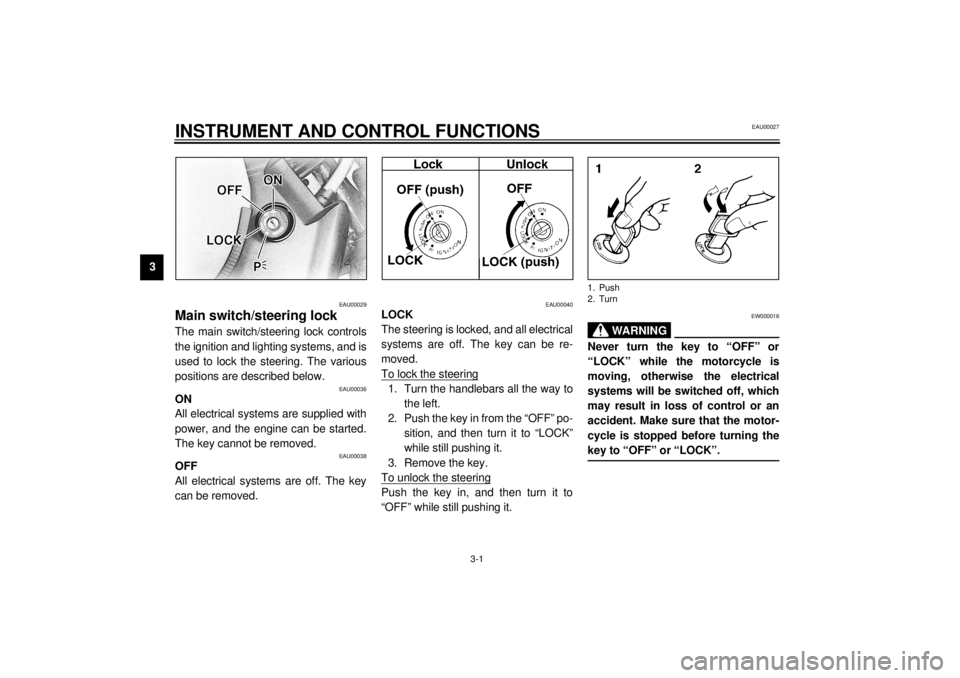
3-1
3
EAU00027
3-INSTRUMENT AND CONTROL FUNCTIONS
EAU00029
Main switch/steering lock The main switch/steering lock controls
the ignition and lighting systems, and is
used to lock the steering. The various
positions are described below.
EAU00036
ON
All electrical systems are supplied with
power, and the engine can be started.
The key cannot be removed.
EAU00038
OFF
All electrical systems are off. The key
can be removed.
EAU00040
LOCK
The steering is locked, and all electrical
systems are off. The key can be re-
moved.
To lock the steering1. Turn the handlebars all the way to
the left.
2. Push the key in from the “OFF” po-
sition, and then turn it to “LOCK”
while still pushing it.
3. Remove the key.
To unlock the steeringPush the key in, and then turn it to
“OFF” while still pushing it.
EW000016
WARNING
@ Never turn the key to “OFF” or
“LOCK” while the motorcycle is
moving, otherwise the electrical
systems will be switched off, which
may result in loss of control or an
accident. Make sure that the motor-
cycle is stopped before turning the
key to “OFF” or “LOCK”. @1. Push
2. Turn
E_5KS.book Page 1 Monday, August 21, 2000 10:48 AM
Page 19 of 104
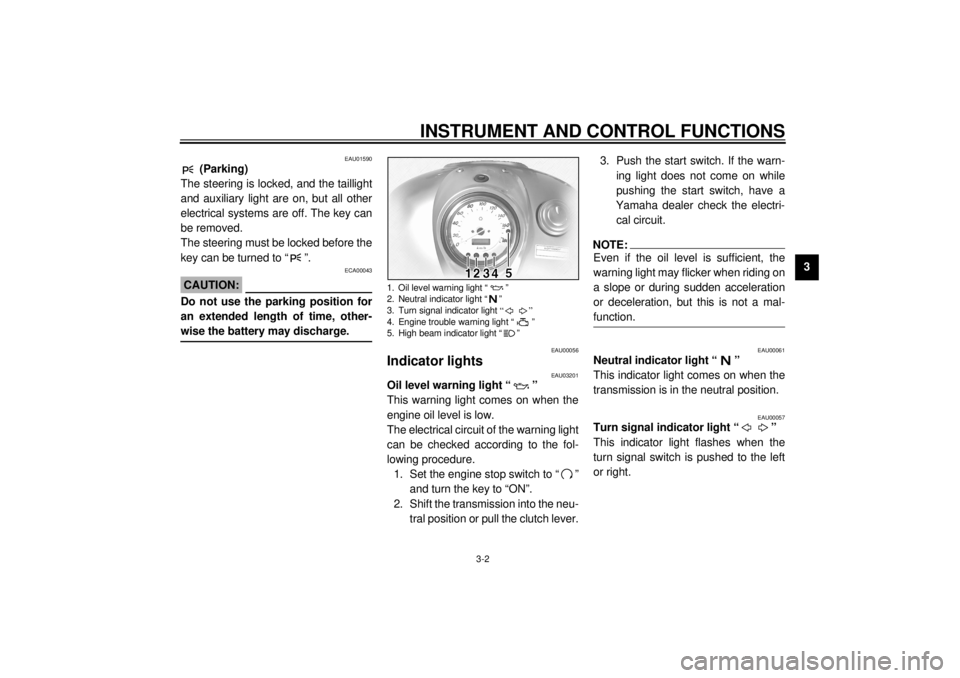
INSTRUMENT AND CONTROL FUNCTIONS
3-2
3
EAU01590
(Parking)
The steering is locked, and the taillight
and auxiliary light are on, but all other
electrical systems are off. The key can
be removed.
The steering must be locked before the
key can be turned to “ ”.
ECA00043
CAUTION:@ Do not use the parking position for
an extended length of time, other-
wise the battery may discharge. @
EAU00056
Indicator lights
EAU03201
Oil level warning light “ ”
This warning light comes on when the
engine oil level is low.
The electrical circuit of the warning light
can be checked according to the fol-
lowing procedure.
1. Set the engine stop switch to “ ”
and turn the key to “ON”.
2. Shift the transmission into the neu-
tral position or pull the clutch lever.3. Push the start switch. If the warn-
ing light does not come on while
pushing the start switch, have a
Yamaha dealer check the electri-
cal circuit.
NOTE:@ Even if the oil level is sufficient, the
warning light may flicker when riding on
a slope or during sudden acceleration
or deceleration, but this is not a mal-
function. @
EAU00061
Neutral indicator light “ ”
This indicator light comes on when the
transmission is in the neutral position.
EAU00057
Turn signal indicator light “ ”
This indicator light flashes when the
turn signal switch is pushed to the left
or right.
1. Oil level warning light “ ”
2. Neutral indicator light “ ”
3. Turn signal indicator light “”
4. Engine trouble warning light “ ”
5. High beam indicator light “ ”
E_5KS.book Page 2 Monday, August 21, 2000 10:48 AM
Page 20 of 104
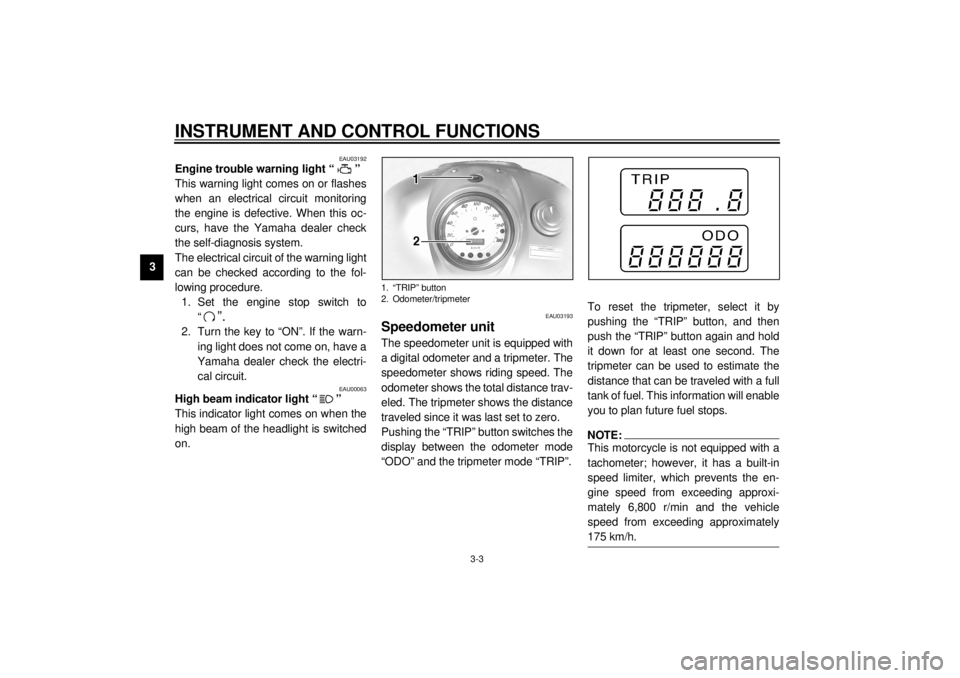
INSTRUMENT AND CONTROL FUNCTIONS
3-3
3
EAU03192
Engine trouble warning light “ ”
This warning light comes on or flashes
when an electrical circuit monitoring
the engine is defective. When this oc-
curs, have the Yamaha dealer check
the self-diagnosis system.
The electrical circuit of the warning light
can be checked according to the fol-
lowing procedure.
1. Set the engine stop switch to
“
”.
2. Turn the key to “ON”. If the warn-
ing light does not come on, have a
Yamaha dealer check the electri-
cal circuit.
EAU00063
High beam indicator light “ ”
This indicator light comes on when the
high beam of the headlight is switched
on.
EAU03193
Speedometer unit The speedometer unit is equipped with
a digital odometer and a tripmeter. The
speedometer shows riding speed. The
odometer shows the total distance trav-
eled. The tripmeter shows the distance
traveled since it was last set to zero.
Pushing the “TRIP” button switches the
display between the odometer mode
“ODO” and the tripmeter mode “TRIP”.To reset the tripmeter, select it by
pushing the “TRIP” button, and then
push the “TRIP” button again and hold
it down for at least one second. The
tripmeter can be used to estimate the
distance that can be traveled with a full
tank of fuel. This information will enable
you to plan future fuel stops.
NOTE:@ This motorcycle is not equipped with a
tachometer; however, it has a built-in
speed limiter, which prevents the en-
gine speed from exceeding approxi-
mately 6,800 r/min and the vehicle
speed from exceeding approximately
175 km/h. @
1. “TRIP” button
2. Odometer/tripmeter
E_5KS.book Page 3 Monday, August 21, 2000 10:48 AM